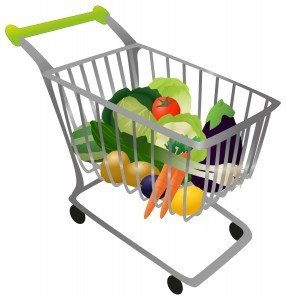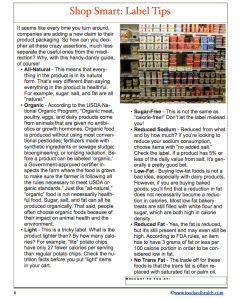Reading Package Claims: A Guide
 It seems like every time you turn around, companies are adding a new claim to their product packaging. So how can your clients decipher all these crazy assertions, much less separate the useful ones from the misdirection? Why, with this handy-dandy guide, of course!All-Natural - This means that everything in the product is in its natural form. That’s very different than saying everything in the product is healthful. For example, sugar, salt, and fat are all “natural.”Organic - According to the USDA National Organic Program, “Organic meat, poultry, eggs, and dairy products come from animals that are given no antibiotics or growth hormones. Organic food is produced without using most conventional pesticides; fertilizers made with synthetic ingredients or sewage sludge; bioengineering; or ionizing radiation. Before a product can be labeled ‘organic,’ a Government-approved certifier inspects the farm where the food is grown to make sure the farmer is following all the rules necessary to meet USDA organic standards.” Just like “all-natural,” “organic” food is not necessarily healthful food. Sugar, salt, and fat can all be produced organically. That said, people often choose organic foods because of their impact on animal health and the environment.Light - This is a tricky label. What is the product lighter than? By how many calories? For example, “lite” potato chips have only 27 fewer calories per serving than regular potato chips. Check the nutrition facts before you put “light” items in your cart.Sugar-Free - This is not the same as “calorie-free!” Don’t let the label mislead you!Reduced Sodium - Reduced from what and by how much? If you’re looking to reduce your sodium consumption, choose items with “no added salt.” Check the label. If a product has 5% or less of the daily value from salt, it’s generally a pretty good bet.Low-Fat - Buying low-fat foods is not a bad idea, especially with dairy products. However, if you are buying baked goods, you’ll find that a reduction in fat does not necessarily become a reduction in calories. Most low-fat bakery treats are still filled with white flour and sugar, which are both high in calorie density.Reduced Fat - Yes, the fat is reduced, but it’s still present and may even still be high. According to FDA rules, an item has to have 3 grams of fat or less per 100 calorie portion in order to be considered low in fat.No Trans Fat - The trade off for these foods is that the trans fat is often replaced with saturated fat or palm oil.Yes, there's a free handout with all this wonderful information. Here you go!
It seems like every time you turn around, companies are adding a new claim to their product packaging. So how can your clients decipher all these crazy assertions, much less separate the useful ones from the misdirection? Why, with this handy-dandy guide, of course!All-Natural - This means that everything in the product is in its natural form. That’s very different than saying everything in the product is healthful. For example, sugar, salt, and fat are all “natural.”Organic - According to the USDA National Organic Program, “Organic meat, poultry, eggs, and dairy products come from animals that are given no antibiotics or growth hormones. Organic food is produced without using most conventional pesticides; fertilizers made with synthetic ingredients or sewage sludge; bioengineering; or ionizing radiation. Before a product can be labeled ‘organic,’ a Government-approved certifier inspects the farm where the food is grown to make sure the farmer is following all the rules necessary to meet USDA organic standards.” Just like “all-natural,” “organic” food is not necessarily healthful food. Sugar, salt, and fat can all be produced organically. That said, people often choose organic foods because of their impact on animal health and the environment.Light - This is a tricky label. What is the product lighter than? By how many calories? For example, “lite” potato chips have only 27 fewer calories per serving than regular potato chips. Check the nutrition facts before you put “light” items in your cart.Sugar-Free - This is not the same as “calorie-free!” Don’t let the label mislead you!Reduced Sodium - Reduced from what and by how much? If you’re looking to reduce your sodium consumption, choose items with “no added salt.” Check the label. If a product has 5% or less of the daily value from salt, it’s generally a pretty good bet.Low-Fat - Buying low-fat foods is not a bad idea, especially with dairy products. However, if you are buying baked goods, you’ll find that a reduction in fat does not necessarily become a reduction in calories. Most low-fat bakery treats are still filled with white flour and sugar, which are both high in calorie density.Reduced Fat - Yes, the fat is reduced, but it’s still present and may even still be high. According to FDA rules, an item has to have 3 grams of fat or less per 100 calorie portion in order to be considered low in fat.No Trans Fat - The trade off for these foods is that the trans fat is often replaced with saturated fat or palm oil.Yes, there's a free handout with all this wonderful information. Here you go! Looking for other ways to help your clients shop smart as they try out their New Year's Resolutions? Here are a few great resources...
Looking for other ways to help your clients shop smart as they try out their New Year's Resolutions? Here are a few great resources...




